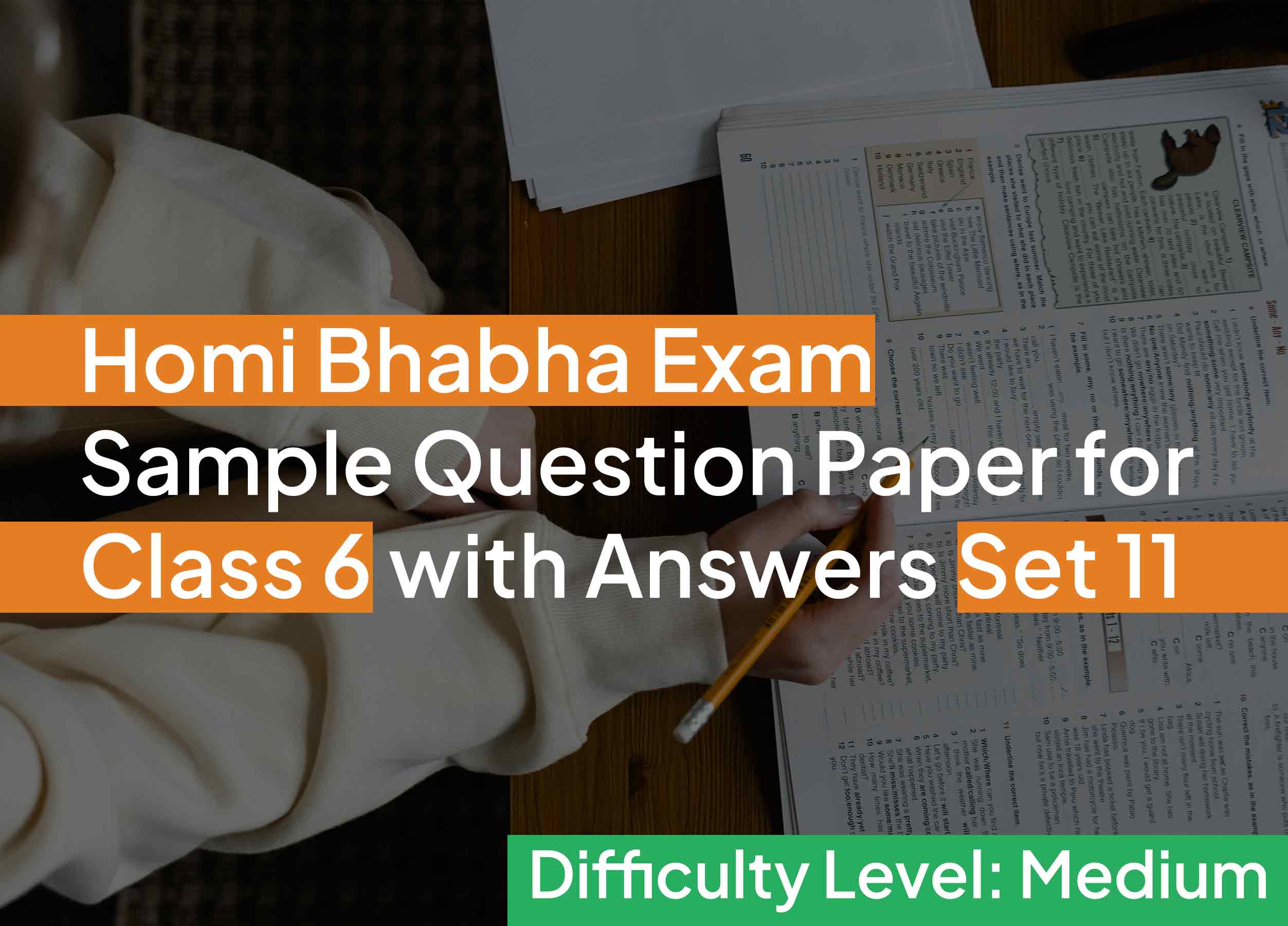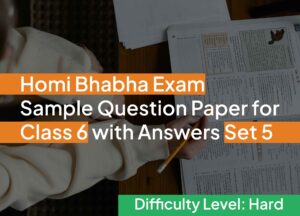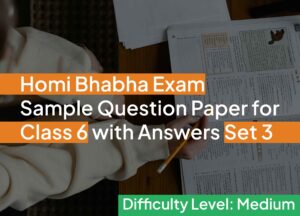Dr. Homi Bhabha Exam sample question paper for Class 6 with our comprehensive set 11 is designed specifically for students following the Maharashtra State Board curriculum, aligning perfectly with the textbooks for 4th, 5th, and 6th standards. This sample question paper is designed to challenge students with in-depth, analytical questions from Maharashtra State Board, CBSE, ICSE, and IB textbooks, covering fundamental science concepts at a high difficulty level.
With questions set at a easy difficulty level, students can effectively enhance their understanding and confidence. Each question aims to challenge students while reinforcing their knowledge, making this resource invaluable preparing for DHBBVS.
Which of the following is a living thing?
a) Stone
b) Tree
c) Plastic
d) Paper
Answer: b) Tree
Explanation: Trees are living things as they grow, reproduce, and respond to their environment.What do animals use to breathe?
a) Gills
b) Lungs
c) Skin
d) All of the above
Answer: d) All of the above
Explanation: Animals use different organs for breathing: fish use gills, mammals use lungs, and amphibians can breathe through their skin.Which part of a plant is responsible for making seeds?
a) Leaf
b) Stem
c) Flower
d) Root
Answer: c) Flower
Explanation: Flowers contain reproductive organs that produce seeds after pollination and fertilization.Which of the following is a natural source of water?
a) Well
b) River
c) Dam
d) Tap
Answer: b) River
Explanation: Rivers are natural sources of water, whereas wells, dams, and taps are human-made.
Which organ controls all the functions of the human body?
a) Heart
b) Brain
c) Kidney
d) Liver
Answer: b) Brain
Explanation: The brain is the control center of the body and regulates all its activities.Which of these is an example of a non-luminous object?
a) Sun
b) Candle
c) Moon
d) Torch
Answer: c) Moon
Explanation: Non-luminous objects like the Moon do not emit their own light but reflect light from other sources.What are the three forms of water?
a) Ice, Rain, Cloud
b) Water, Ice, Steam
c) Snow, Hail, Dew
d) Solid, Gas, Vapor
Answer: b) Water, Ice, Steam
Explanation: Water exists in three states: liquid (water), solid (ice), and gas (steam).Which of the following animals is cold-blooded?
a) Dog
b) Lizard
c) Elephant
d) Monkey
Answer: b) Lizard
Explanation: Cold-blooded animals, like lizards, rely on their environment to regulate body temperature.Which part of the human body helps in digestion by producing bile?
a) Stomach
b) Liver
c) Intestine
d) Pancreas
Answer: b) Liver
Explanation: The liver produces bile, which helps in the digestion and absorption of fats.What do you call the movement of water from the Earth to the atmosphere and back?
a) Water Cycle
b) Carbon Cycle
c) Nitrogen Cycle
d) Oxygen Cycle
Answer: a) Water Cycle
Explanation: The water cycle involves the continuous movement of water through evaporation, condensation, and precipitation.What is the primary purpose of roots in plants?
a) To store food
b) To absorb water and nutrients
c) To produce seeds
d) To provide shade
Answer: b) To absorb water and nutrients
Explanation: Roots absorb water and nutrients from the soil to support the plant’s growth.Which planet is the smallest in our solar system?
a) Mercury
b) Mars
c) Venus
d) Pluto
Answer: a) Mercury
Explanation: Mercury is the smallest planet in the solar system.
What is the unit of force?
a) Meter
b) Kilogram
c) Newton
d) Pascal
Answer: c) Newton
Explanation: The SI unit of force is the newton, named after Sir Isaac Newton.Which organelle in a plant cell contains chlorophyll?
a) Nucleus
b) Chloroplast
c) Mitochondria
d) Vacuole
Answer: b) Chloroplast
Explanation: Chloroplasts contain chlorophyll, which is essential for photosynthesis.What is the phenomenon of bending of light called?
a) Reflection
b) Refraction
c) Diffusion
d) Absorption
Answer: b) Refraction
Explanation: Refraction is the bending of light as it passes from one medium to another.Which of the following is NOT a property of light?
a) Light travels in a straight line
b) Light can bend around corners
c) Light can be reflected
d) Light can be refracted
Answer: b) Light can bend around corners
Explanation: Light travels in straight lines and can only appear to “bend” due to reflection or refraction.What is the speed of sound in air at room temperature?
a) 150 m/s
b) 343 m/s
c) 1000 m/s
d) 3000 m/s
Answer: b) 343 m/s
Explanation: At room temperature (about 20°C), the speed of sound in air is approximately 343 m/s.Which of the following substances is a good conductor of electricity?
a) Plastic
b) Wood
c) Copper
d) Rubber
Answer: c) Copper
Explanation: Copper is a good conductor of electricity due to its free-flowing electrons.Which phenomenon is responsible for the twinkling of stars?
a) Reflection
b) Refraction
c) Diffraction
d) Scattering
Answer: b) Refraction
Explanation: Twinkling occurs because of the refraction of starlight by the Earth’s atmosphere.What is the chemical formula for water?
a) CO₂
b) H₂O
c) NaCl
d) O₂
Answer: b) H₂O
Explanation: Water is composed of two hydrogen atoms and one oxygen atom, hence its formula H₂O.Which gas is released during photosynthesis?
a) Oxygen
b) Carbon Dioxide
c) Nitrogen
d) Hydrogen
Answer: a) Oxygen
Explanation: Plants release oxygen as a byproduct of photosynthesis.What is the smallest particle of an element?
a) Molecule
b) Atom
c) Ion
d) Proton
Answer: b) Atom
Explanation: Atoms are the smallest particles of an element that retain its properties.Which of these is NOT a mixture?
a) Air
b) Salt solution
c) Water
d) Soil
Answer: c) Water
Explanation: Pure water (H₂O) is a compound, not a mixture.What is the process of converting a solid directly into gas called?
a) Melting
b) Sublimation
c) Evaporation
d) Condensation
Answer: b) Sublimation
Explanation: Sublimation is the process where a solid changes directly into gas without becoming liquid.Which of the following is NOT a type of carbohydrate?
a) Glucose
b) Protein
c) Starch
d) Cellulose
Answer: b) Protein
Explanation: Proteins are made of amino acids, not carbohydrates.Which organ in the human body is responsible for filtering blood?
a) Liver
b) Kidney
c) Heart
d) Lungs
Answer: b) Kidney
Explanation: The kidneys filter waste products and excess substances from the blood.Which force pulls objects towards the center of the Earth?
a) Friction
b) Magnetic Force
c) Gravitational Force
d) Nuclear Force
Answer: c) Gravitational Force
Explanation: Gravity is the force that pulls objects towards the center of the Earth.What happens to the volume of water when it freezes?
a) It increases
b) It decreases
c) It remains the same
d) It vanishes
Answer: a) It increases
Explanation: Water expands when it freezes due to the unique arrangement of hydrogen bonds in ice.What is the function of red blood cells in the human body?
a) To fight infections
b) To transport oxygen
c) To help in clotting
d) To produce hormones
Answer: b) To transport oxygen
Explanation: Red blood cells carry oxygen from the lungs to other parts of the body using hemoglobin.Which one of these is NOT an example of kinetic energy?
a) A moving car
b) Water flowing in a river
c) A ball at the top of a hill
d) A spinning fan
Answer: c) A ball at the top of a hill
Explanation: A ball at the top of a hill possesses potential energy, not kinetic energy.What is the common name of sodium bicarbonate?
a) Table salt
b) Baking soda
c) Bleaching powder
d) Vinegar
Answer: b) Baking soda
Explanation: Sodium bicarbonate is commonly known as baking soda and is used in cooking.Which part of the human eye is responsible for focusing light?
a) Retina
b) Cornea
c) Lens
d) Iris
Answer: c) Lens
Explanation: The lens adjusts its shape to focus light onto the retina for clear vision.What is the energy source for the water cycle?
a) The Moon
b) The Sun
c) The Earth’s Core
d) Stars
Answer: b) The Sun
Explanation: The Sun provides the heat energy required for evaporation in the water cycle.Which gas is essential for respiration?
a) Nitrogen
b) Carbon Dioxide
c) Oxygen
d) Hydrogen
Answer: c) Oxygen
Explanation: Oxygen is essential for the process of respiration in most living organisms.What type of energy is stored in a stretched rubber band?
a) Kinetic Energy
b) Potential Energy
c) Thermal Energy
d) Electrical Energy
Answer: b) Potential Energy
Explanation: A stretched rubber band stores potential energy, which is released when it is let go.
Who is known as the “Father of Modern Physics”?
a) Isaac Newton
b) Albert Einstein
c) Galileo Galilei
d) Nikola Tesla
Answer: b) Albert Einstein
Explanation: Albert Einstein is called the “Father of Modern Physics” for his contributions to the theory of relativity.What is the largest planet in the solar system?
a) Earth
b) Jupiter
c) Saturn
d) Neptune
Answer: b) Jupiter
Explanation: Jupiter is the largest planet in the solar system, with a diameter of about 139,822 km.Which metal is liquid at room temperature?
a) Mercury
b) Iron
c) Gold
d) Silver
Answer: a) Mercury
Explanation: Mercury is a metal that remains in liquid form at room temperature.What is the main component of natural gas?
a) Hydrogen
b) Methane
c) Oxygen
d) Carbon Dioxide
Answer: b) Methane
Explanation: Natural gas primarily consists of methane, which is a hydrocarbon.Who invented the telescope?
a) Galileo Galilei
b) Johannes Kepler
c) Isaac Newton
d) Hans Lippershey
Answer: d) Hans Lippershey
Explanation: Hans Lippershey is credited with inventing the telescope in the early 17th century.
If you find this useful, share it with your friends… so they can join you in preparing for Dr. Homi Bhabha Balvaidnyanik Competition or DHBBVS. Together, you can tackle these questions, discuss the answers, and strengthen your knowledge base.
Start reading, keep preparing and stay focused! Let’s achieve greatness together!




